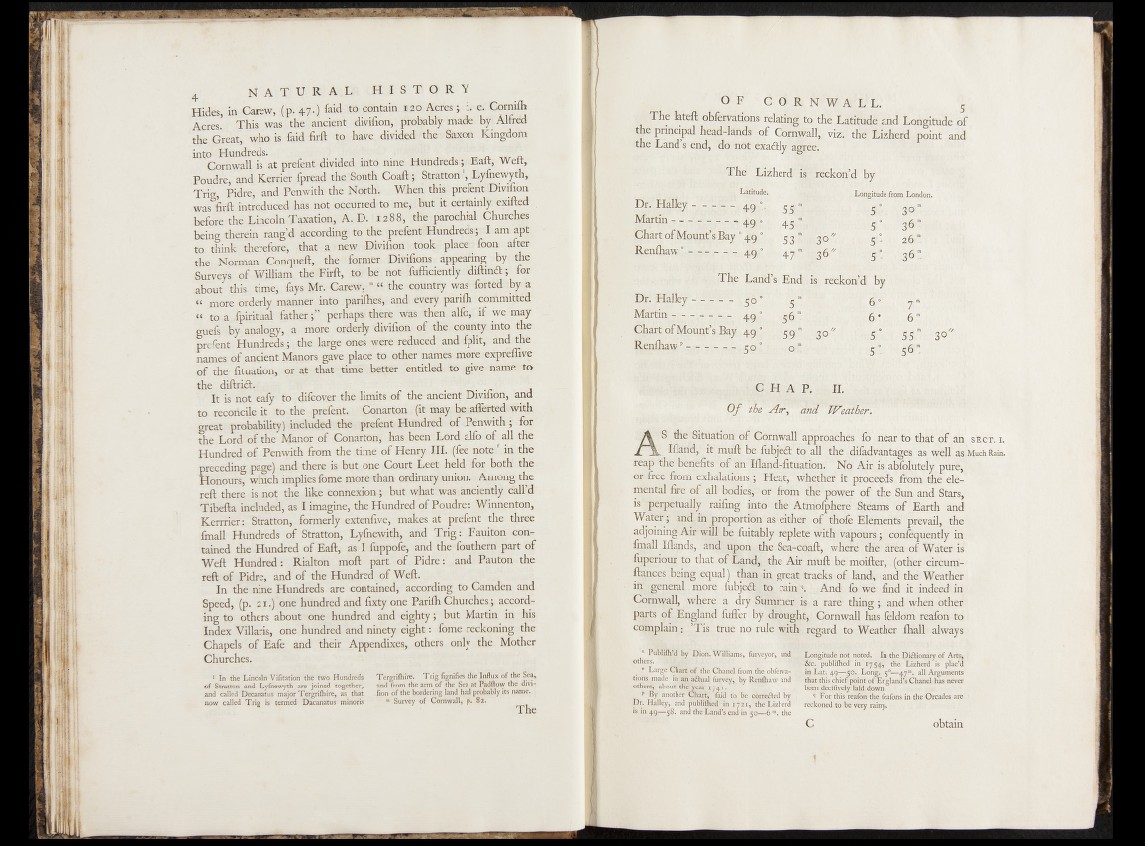
Hides, in Carew, (p. 47.) Md to contain ï 29, Acres; i. e. Corniii
Acres. , This was.,the'‘ancient made. by:.Alfrbd
the Great, who is faid firft to have, divided .'the^-Sasxon Kingdom
into ■ Hundreds. 'i:/-)' .Mochtu*> .ffsg&fo ->^yj ö _
Cornwall is at prefent divided intonine. Hundreds ;;.Eaft; Weit,
Poudre, and Kerriet Jpr^d the.^fnih Go^it:; S.tikttoriSy&ewyth,1 I
Trig, Pidre, and Penwith the North. When this- prefent'IDivifion
was firft introduced has not occurred to'lmsjj But it: certainly! efofted ,
before the Lincoln Taxation, A. D. 1288, tthte parochial Churches
being therein rang’d according: to the prefentTIundreds; I am apt,
to think therefore, rthat ajjnew Divifionjtook/placeiiloon:after
the Norman Conqyeft, the former Divifions appearing sby/idae
Surveys of William the. Firft, M be', f®r
about m )t k e ,; ^ Mr. Carew*-“ the eountiy w&fofoftéd b y a
« more orderly manner into .parifoes, and eyery parifh committed
ct to a fpiritual father ;” perhaps; there was '.then 'alfoyJf LW© may
guefs by analogy, a more orderly divifions of the county .into, -the
prefent Hundreds; the large ones were reduced andfplit, and the
names of ancient Manors gave place to other names mor.eyexprifTi-ve
of the fituatbn, or at that time'better entitled.'to ;gve name to
the diftfoft. ; k 3 . ,
It is not ealy to difeoyer the limits of the ancient. Divifibn, and
to reconcile it to the prefent, Cqnarton .(it may fcaieEted.wi^
great probability) included |M-efent Hundred •< t)f<P,enwith ; - for
the L ord o f the Manor o f Conarton,' has been lx xd '& & c& 'A \ the
Hundred of Penwith from the time of Henry Ill.yffeë- notejlm.the
preceding page) and there is but .one Court Leet held for both? the
Honours, which implies fome more than ordinary union.'t Among the 1
reft there is not the l i e connexion; but what'was. anciently Gall’d
Tibefta included, as I imagine, the Hundred of Poudre: Wintientqn,
Kerrrier: Stratton, formerly extenfive,? makes at prefect 'th e three
finall Hundreds of Stratton, Lylnewith, and Trig: Fauiton contained
the Hundred of Eaft, as I fuppofe, and the-foutheffi part of
Weft Hundred: Rialton raoft part of Pidre: and Panton the
reft of Pidre, and of the Hundred of Weft.
In the nine Hundreds are contained, according to Camden and
Speed, (p. 21.) one hundred and fixty one Parifti Churches; according
to others about one hundred and eighty; but Martin in his
Index Villaris, one hundred and ninety eight: fome reckoning the
Chapels of Eafe and their Appendixes, others only the Mother
Churches.
1 In the Lincoln VHItation the two Hundreds Tcrgrilhire. Trig fignifies the Influx of the Sea,
of Stratton and Lyfiiewyth are joined together, and from the arm of the Sea at Padftow the drn-
and called Decanatus major Tergrilhire, as that -fton of the bordering land had probably its name. ,
now called Trig is termed Dacanatus minoris m Survey of Cornwall, p. 82.
The
fThe’iateft öfcfdmtions'relating' to the Latitude and Longitude o f
foe principal héad-dands- of Côr®all,. viz? tiid'Lizherd point and
*he Land’s* é'dfo do ndt!'elaétiWagree.
i*Th& Lizherd^w^-reckon’^ by \l
Latitude. ^ ^ Longitud^ from London.
S K I l s I g g | W Ê m
ChartoftMatantisBav “ ..ofei* , w < 2 6 “
----- 49/ > r g H g B B - :
^ The LaiM’s' Enfojis reckoned by' s f
Martin - g - f7 5 B g g g | | g g * g | g g g 6 ”
Qaart of Mount’s Bay , 491° , ! mS ° 5 5 ”
j|enfoa\yp ^
d^C H 'A P. II.
O f w f ftiry amT^fvea^^- ‘
Jfoe’Situation'of GOTnwaft anpfoaches lb,near to that öf;tfo sect. i,
IlllHM,*-it mult be lubjeët’ tq aft the .difadvantages as well as Much Rain,
reap thb- benefits' o f & Mand-fituation. No Air is abfolutely, pure^
or free from exhalations; Heat, whether ft proceeds from the ele-’
mental fifo of all bodies,^ or from the power of' foe Sun and Stars,
isperpetually railing into the Afrrfolphere Steams of Earth and
Water ; and. in ^proportion as: either of foofe Elements prevail, the
adjoining Air wflbbie fuitably replete with vapours ; conlifouentiy in
Imall Illands, ahd' upon foe Sea-coaft, where the area of Water is’
fupetiour to that I^nfo the Air muft be moifter,.. (other eircum-
ft^aces being equal) than in great tracks of land, and thé Weather
ih))general .more fubje«^ to rain \|..And fo we find it indeed in
Cornwall, where a dry Summer is a rare thing; and when other
Parts of England liiffer by drought, Cornwall has leldom reafon to
coinplain : ’Tis true no tule with- regard to Weather ftiall always
" Publilh’d by Dion. Williams, fiirveyor, and ’ Longitude not noted. In the Diftionary óf Arts, i
,0thte. _ - V? &c- publiflied iii 1754', the Lizherd is' plac’d
0 -^arge Chart of the Chanel from the obferva- ,&in Lat. 49—-^o. Long. 50—47m. all Arguments
.|5a(^e. *5 SI 8-^ual fumy,., by Rfr^iaw and that this chief point of England's Chanel has never
. been decifively laid down.
p another ...to 'be. ^nie£led iy 8 For this reafon the feafons in the Örcades are |
Dr. Halley, and pübliflfed in 172^1, the Lizherd reckoned to be very rainy,
is in. 49,-58. and the Land’s end in 50— 6 in. die
I € obtain